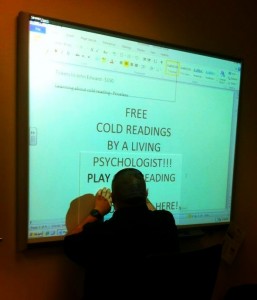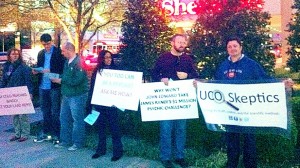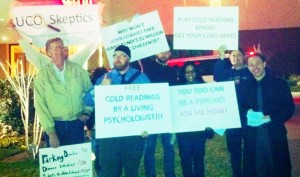
This past spring, the student group that I advise (the UCO Skeptics) put on a protest of two appearances by John Edward (supposed psychic medium). In addition to appearing on the local news (both television and online), I was asked by Barry Karr (director of the Committee for Skeptical Inquiry, a Center for Inquiry affiliate) to write up an article for Skeptical Inquirer about our experience. Being a long-time fan of both CFI and CSI (the real one, not the television show, which I have never watched), I jumped at the chance. It was published at the start of last month:
Caleb W. Lack – How to protest a ‘psychic’
I have had lots of very positive feedback to the article (including a nice write-up by my friend Abbie over at ERV), so I thought I would publish a “special edition” version of the article here, with photos/video as well as some tips on how to use the basic form of our protest (and the lessons we learned) in any kind of pseudoscience protest. Although I’ll be quoting from my SI article, you might want to go read it first, then come back here. Don’t worry, I’ll wait.
So, why would we choose a target like John Edward to protest? Here’s what I said in the article –
…there are a few things that just rile us up, making us want to shake people and scream data at them. On that list are so-called psychics, especially those who prey on the bereaved by claiming they can communicate with the dead. All of their “powers” are easily duplicated using sleight of hand or cold reading techniques, and this has been well documented for decades by skeptical icons like James Randi and Ray Hyman. Unfortunately, the average person on the street is unaware of this information, as evidenced by the fact that Edward can charge $150 per person for a seminar where he “talks” to the dead…and draw hundreds of people even in a state as conservatively religious as Oklahoma.
For further explanation, I’ll let my friends Matt and Trey explain via a short animated exposition:
http://www.southparkstudios.com/clips/103512/crossing-over

Basically, this guy is a really, really good bullshitter who knows all about the confirmation bias (“remember the hits, forget the misses”). He uses well-known techniques, which anyone can learn, and then claims to have amazing talents and information from the dead, when in reality he is doing nothing of the sort. Although many will disagree with me, I think the “hope” and “comfort” he supposedly gives people are nothing but lies and deception, and the only person who ends up doing well in the long run is John himself, by profiting from misfortune.
Let me now hit the nitty and the gritty of doing a protest. These can be applied to any protest, but I’m tailoring this to one intended to be informative and entertaining, not angry and cynical, about a pseudoscientific topic.
Step 1 – Taking care of pre-protesting business
One of the biggest pieces of advice I have for protestors is to make sure that you are doing everything by the book. This will almost always mean obtaining a permit to protest prior to doing anything else. You cannnot be denied a permit to protest, you just need to get one.
“But it’s my right to protest!” you might say. True, but you still need to follow the rules. Almost all cities and townships require you to file that you will be holding a protest, including how many people are expected to be there and where you will be.
Your next thing to take care of will be learning what is and is not acceptable behavior at the protest, and then conveying that information to all your fellow protestors. This is usually just commonsense things like not blocking traffic, impeding pedestrian flow on a sidewalk, and such.
Given that people holding signs tend to be viewed as semi-crazy by the average person driving or walking by (we were, at least, it may differ for you), I would highly recommend that all of the protestors wear either a) business-casual attire or b) matching shirts that have the name of your organization (or a pithy slogan) on them. These options tell your audience that you are a professional, well-organized group of people, and not someone to cross the street because of.
Be sure you drum up some attention for yourself and the protest by contacting various media outlets (e.g., newspaper, television, websites) and use social media (e.g., Facebook, Twitter) to spread the information to as many people as possible.
… in the week leading up to the protest, I called the news desk of every television station in the Oklahoma City metro area, letting them know what we were doing, when we were doing it, and giving them our contact information….
Spread the information around to enough sources, and you’ll likely get some hits:
Protest paraphernalia is crucial to an effective and educational time, so don’t put off constructing those until the last minute. I really recommend having both signs and handouts, as the combination can help capture people’s attention and then provide them with further information even if they can’t stay and have a conversation with you. Keep in mind what Mitch Hedberg said about flyers, though, and try to make them as concise and useful as possible. Here’s what ours contained –
I designed the handouts to be a single sheet of paper, folded in half so it resembled something fancier than what it was. We included several pieces of information in the handouts. Our name and a catchy title for the handout filled the front cover, in order to let people know exactly what they were getting into. When they opened it up, they found a brief explanation of what cold-reading is and typical ways “psychics” use those skills to make it appear they have supernatural powers. We also included a “cold-reading bingo” card (shamelessly borrowed from this site) so that people could play along either at the show or at home later. On the back side, we included a list of further resources on cold-reading, a brief statement about who we (the UCO Skeptics) are, and how to get into contact with us (including a QR code that linked to our website).

Making the posters is a great way to gather all of your protestors in one place prior to the event. This allows you to not only work on group cohesion, but also to get your brains together to make signs that are entertaining and informative. You can also plan out what your slogan(s) will be to catch the attention of passers-by. My major recommendation about posters would be that you do not just free-hand them. They’ll look much better and be more readable if you use a computer projector or other means (stencils, anyone?) to make your letters uniform.
The last bit of pre-planning I recommend is educating yourself. If you are protesting an anti-vaxer, then be informed on why vaccines are so important; if it’s a psychic, understand why and how people are fooled into thinking they have magical powers (or have a person trained in cold-readings, like I am). You’ll need at least one person (but ideally many, many more) who have some expert-level knowledge of the subject.
Step 2 – The art and science of protesting
On the day of the protest itself, you want to ensure that things go as smoothly as possible. To help facilitate that, here are some basic actions to take.
First, be sure to bring a copy of the permit with you. This will help to show anyone who questions your right to be there that you have followed (and are following) proper protocol and procedures.

Second, make sure your fellow protestors know when and where to meet. This includes where the best areas are for parking relative to the protest site or directions from the nearest public transportation stops. Encourage people to be there about 30 minutes earlier than the planned beginning of the protest, so you can have time for latecomers to straggle in.
Third, if you are protesting in a public location (which you likely will be), inform nearby businesses, hotels, and vendors what exactly you are doing and why. Emphasize that you are not there to disrupt flow of traffic into their location, and will not be blocking the sidewalks. This isn’t something you have to do, but it’s the nice thing to do and can help to dissuade any negative feelings towards your group. We did this and it went great:
…we informed the general management of the hotel holding the event that we would be outside, what we would be doing, and why we were doing it. After they were assured that we would be a) non-violent and b) not blocking entry into the hotel, they were completely fine with us protesting, and even said how much they appreciated us informing them in such a polite manner.
Fourth, don’t be aggressive during your protest. Humor can help to disarm many a terse confrontation, while anger will likely only make it worse. Try not to get into shouting matches, but instead put your points across in as calm and non-emotional a manner as possible.
Fifth, have a good time! Look friendly, be nice, smile. It will make people not cross the street to avoid you (well, not as much).

Step 3 – After the protest
 Now it’s time to celebrate! I would really recommend that everyone involved in the protest go out together afterward for dinner, drinks, or cookie cake (what? I love me some cookie cake….). This will help to increase your group cohesiveness as well, so that the next time you want to have a protest, people will associate it with not just the excellent time of protesting, but fun with friends afterward, as well.
Now it’s time to celebrate! I would really recommend that everyone involved in the protest go out together afterward for dinner, drinks, or cookie cake (what? I love me some cookie cake….). This will help to increase your group cohesiveness as well, so that the next time you want to have a protest, people will associate it with not just the excellent time of protesting, but fun with friends afterward, as well.
After you come down from your “doing an awesome civic duty” high, you need to try to get the word out a bit more, but this time about your accomplishment. Write it up for a local newspaper (if they didn’t cover), a website, your group’s blog, or ask to do a guest post on someone’s site (hit me up, I’d love to hear what others are doing).
Hopefully, this has been a useful primer on how to do a protest. I would be very interested in hearing comments and feedback, and I’ll incorporate good ideas into this guide.
